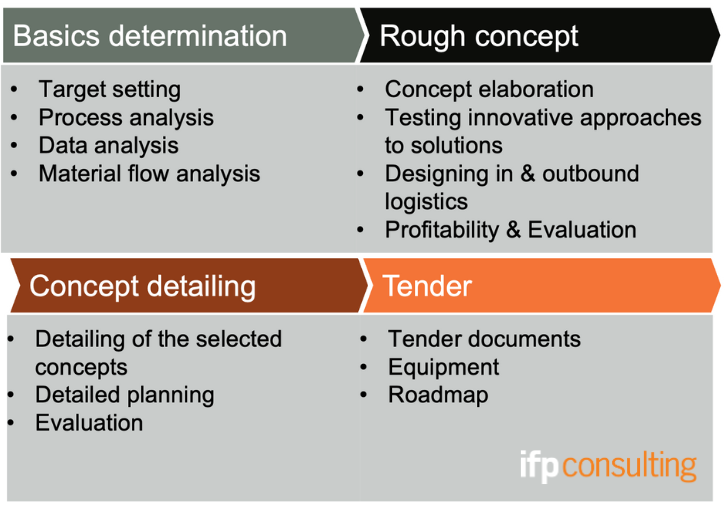Intralogistic planning
We advise you individually so that you can find the right intralogistics concept.
Services in the field of production and logistics
Services in the field of production and logistics
Intralogistics – From concept to implementation
Standardization for automated guided vehicles
The AGV (automated guided vehicle) has experienced a strong renaissance in recent years. Today’s concepts are easier to install, maintain and adapt during operation than was the case in the past.
However, initial implementations in the automotive industry in the 1980s often did not bring the hoped-for success. Due to the technological leap in terms of navigation, control and data transmission over the last 30-40 years, AGVs are experiencing increasing relevance.
In addition, the initially very high investment costs have fallen sharply in recent years, so that implementation today often pays for itself after just a few years. The often high automation potentials and the requirements on the flexibility of the planned system are decisive for the implementation in practice. But with or without AGVs, the focus must be on high cost efficiency for the non-value-added activities of intralogistics.

Analyze and design material flow holistically
What is our understanding?
At ifp consulting, we see intralogistics as an essential support process that must be designed to be reliable, performance-oriented, efficient and future-proof. Because intralogistics means more than just technology and processes. It always comes down to a coherent overall concept that takes into account all aspects in your company and incorporates them into a fully comprehensive logistics plan.
In the first step of intralogistics consulting, our specialists work with you on site to analyze the current situation, your goals, and use this information to develop processes that are precisely tailored to your requirements. In doing so, we rely on data-based analyses of processes and material flows, on the basis of which we develop different intralogistics concepts for you.
Intralogistics issues
The framework of intralogistics is determined by the layout of the workstations and the loading and unloading stations. This is where the first question arises: Does the layout still fit my material flow? In practice, problems often arise from hotspots where material is jammed or individual sections that are heavily frequented by industrial trucks. In addition to inefficiencies, this can also create a safety risk: Material is temporarily stored in aisles, which means that the original aisle width is no longer sufficient and there are no longer any fallback options.
The continuing questions refer to the system suitable for production or logistics. At what transport volume does it make sense to switch to conveyor technology? What conditions must be met for investments in automation to pay off? How can fluctuations in performance be covered without leading to high fluctuations in staffing requirements?
Standardization for automated guided vehicles
Process preparation
Interview with logistics expert Denise Pohlig, Managing Director at ifp consulting, on driverless transport systems as the material handling and transportation process of the future: What are the requirements?
Ms. Pohlig, developments in autonomous driving, camera systems, mobile communications and GPS technology are rapidly increasing the desire to introduce automated guided vehicles (AGVs). Does automation already make sense for medium-sized companies?
You certainly have to look at this in a differentiated way. On the one hand, we are currently noticing, particularly in the environment of production in medium-sized companies, that companies in this situation are increasingly concerned about their dependence on personnel availability and are also noticing the savings opportunities and falling costs for the technical equipment of the AGV. On the other hand, many companies are not yet ready, because the stability of upstream and downstream processes in particular plays an important role alongside standardization. If this preparation of the processes does not take place, or if it is too incomplete, then the potential of AGVs and automation in logistics is not fully exploited and the often high expectations of employees and management cannot be met.
In recent weeks, they have been on site at the companies to check the feasibility of an AGV. What was your impression: how can companies participate in the progress of automation in the best possible way?
If the conditions are not right, the potential for optimization is limited. Therefore, from our point of view, it is important that certain conceptual considerations take place beforehand. First, the company can calculate the opportunity costs, also to weigh the need for automation. In doing so, we record the material transport processes for the customer, taking into account the properties of the materials to be transported, such as weight and dimensions. Not every material is suitable for transport by AGV. Through an appropriate review together with the customer, we then decide which departments need to be brought on board and, finally, which type of AGV should be considered.
How is the decision for the right AGV made – is there a catalogue of criteria or are the various manufacturers included in the selection process?
Both are possible and are considered in consecutive steps in the AGV planning. First, we narrow down the potential AGVs using the ifp criteria catalogue and by analyzing the material flow and the material portfolio. For example, we investigate whether a pallet AGV or an AGV for small load carriers (KLTs) is best suited for the customer and what performance requirements the AGV should fulfill. The material flow analysis is used to determine the transport intensity, i.e. the number and volume of transports, and the number of systems required is determined from this. In addition to the operational requirements for the AGV, we naturally also integrate the information technology connection to the existing system into our analysis. We then usually contact and integrate different manufacturers in order to be able to plan a complete solution for our customers. Many of our customers do not consider at the beginning of the project that the control system and its connection to the existing system should not be disregarded in AGV planning and represents a significant part of the costs.
Ms. Pohlig, you said at the beginning that process preparation is the decisive feature for a successful introduction of the automated guided vehicle system. In what way?
When introducing an AGV, companies digitize part of their logistics processes. This is often the first point of contact for the company on the subject of “Industry 4.0”. A prerequisite for digitization is always a deep understanding of processes by the project team carrying out the work in order to define the right solution for the company, because an AGV solution is always individual.
In practice, we, as ifp consulting, recognize again and again that especially in the medium-sized sector the focus is on production and logistical processes are not part of the core competence of the companies. Logistics is often still a means to an end here. The degree of standardization of logistics processes is correspondingly low: Responsibilities are not clearly defined, transports are controlled organizationally and not via the system, and some logistical activities are also performed by the machine operator. As a result, there are usually no comprehensive process descriptions, which are the basis of any process automation. In addition to the process definition, the degree of automation of upstream and downstream processes is also crucial. Without automation during load transfer between machine and AGV, the human factor is still necessary, making AGV projects more complex. The first step here is to determine the appropriate scope of the solution on the basis of a TARGET process.
Perhaps we could be a little more specific: Where exactly are the savings potentials now?
As just mentioned, standardization and improvement of logistics processes in the context of AGV implementation is the driver for operational excellence and standardization. An intensive examination of the operational company processes is a necessary prerequisite for the successful introduction of an AGV. In addition, topics such as standard number of parts and automation potential are brought into focus by the project, thus automatically questioning the future viability of the production system.
However, the initial aim of an AGV introduction is to reduce personnel costs. These are to be expected in particular in the area of direct personnel costs. Also to be evaluated separately is independence from personnel availability, which represents a major challenge for many companies, especially outside metropolitan areas. Transport damage within the logistics chain can also often be reduced through the precise use of AGVs.
How do you assess the situation in Germany? Will the use of driverless transport systems increase in the near future?
I am convinced of that. We have recently noticed a significant increase in interest from our customers, especially in medium-sized companies. The technology is now correspondingly widespread and already has a high level of acceptance in the workforce. These are good prerequisites for using AGV solutions as automation and digitalization drivers in companies and leveraging their potential. Nevertheless, the comprehensive project planning effort should be mentioned at this point, which is particularly necessary in the case of grown structures in order to ensure the successful implementation of AGV concepts.
We support you in the development of the intralogistics concept
- Process & weak point analysis
- Transport equipment & load carrier systems
- Picking & staging concepts
- Concept development (layout evaluation / optimization) (visTable)
- Material flow analysis / material flow simulation PlantSim
- Economic evaluation of the developed concepts
- Traffic concept
- Tender documents (specifications, etc.)
Factors of success
We think through the entire process chain and compare conventional and innovative solutions for you – because with AGVs, autonomous driving is at least as exciting as the loading and unloading process. The goal is to find the right solution for your company through variants and process transparency, and to develop a realistic intralogistics concept that fits your company.
What needs to be considered during implementation?
- Last but not least, other factors such as the information base and the information systems on the basis of which the transport orders are processed play a decisive role.
- As the interface between process and materials management, intralogistics is a complex system and naturally under cost pressure.

Intralogistics
Take away
With or without driverless transport systems, the focus must be on a high cost efficiency for the non-value-added activities of intralogistics.


